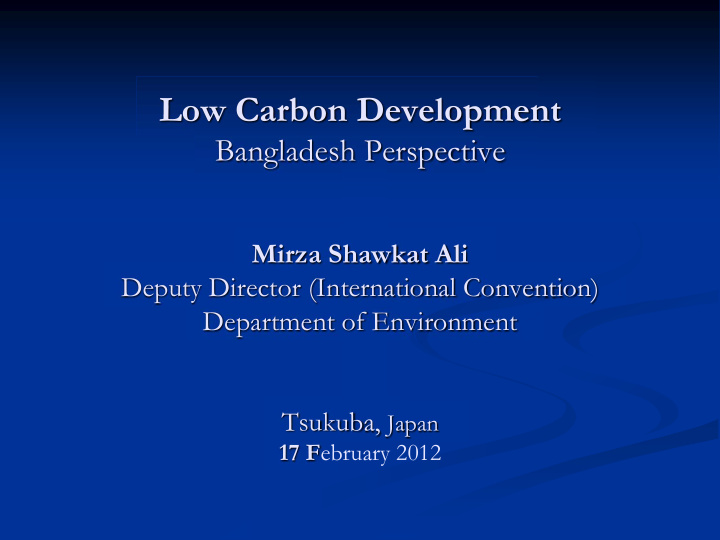



Low Carbon Development Bangladesh Perspective Mirza Shawkat Ali Deputy Director (International Convention) Department of Environment Tsukuba, Japan 17 F ebruary 2012
BCCS&AP For Bangladesh Adaptation is the priority; National Adaptation Programme of Action (NAPA)- Submitted to UNFCCC in 2005 Focus of UNFCCC supported NAPA was only urgent and immediate adaptation activities; Government required a Comprehensive Programme; Ministry of Environment and Forests took the initiative to prepare the BCCS&AP in 2009.
Cyclone Storm surge, salinity Drought Hazards Bangladesh faces Flood Water logging Bank erosion Bank Erosion
Destruction by Cyclone Sidr Part of Sundarban Mangrove Forests, the largest Mangrove Forests of the World
Impact of AILA
People’s Response to Post -Aila Situation Migration to urban areas from Kalabogi Village, Dacope
Six Pillars (Thematic Areas) of Action Plan Food security, social protection and health Comprehensive disaster management Infrastructure Research and knowledge management Mitigation and low carbon development Capacity building and institutional strengthening The Action Plan will be implemented as the integral part of National Development Policies, Plans & Programmes
Mitigation Opportunities in Bangladesh
Mitigation under SNC SNC made an inventory of GHG emission for the year 2001 and 2005. Per capita GHG emission in BD was 0.27 tons in 2005 (130 million population)
Energy sector total GHG emissions projection for 2005-2030
Trend in CO 2 Emission from Manufacturing Industries
CO 2 Emission by Different Types of Transportation
Growth in GHG emissions from 1990 to 2005
Growth rate of emission from sectors (2001-05) Sector Yearly change (%) 6.39 Energy Industry 0.27 Agriculture 3.29 LUCF - 1.38 Waste 3.52
Mitigation Initiatives in Bangladesh Bangladesh as a LDC are not obligated to mitigate or reduce GHG emission. But the government considered to maintain a low carbon development path. So, BCCSAP has a „Mitigation and Low Carbon Development‟ pillar. Some sectoral initiatives have been undertaken Introduction of renewable energy especially solar photovoltaic by far are regarded the best mitigation initiative in Bangladesh.
Cont.. CDM initiatives have been undertaken 9 projects approved by DNA 3 registered at CDM Executive Board 1 has gone into implementation BOCM is being promoted by Japan recently
Power Sector Government is committed for providing electricity to all by 2021 Generation capacity will be 37,000 MW by 2030; out of which 16,000 MW from imported coal 5,000 MW from nuclear power and 3,000 MW from regional grid of India, Nepal, Bhutan and Myanmar.
Energy Savings Programme Govt. has undertaken energy savings programs along with power generation; Under the “Efficient Lighting Initiative of Bangladesh” Govt. has distributed 10.5 million CFLs (23W & 14W) to 4.5 mn. consumers at no cost in two phases (June & October 2010) It is observed that 90.14 MW demand reduced after 1st phase distribution (5.5 million CFLs) and 158.04 MW demand reduced after 2 nd phase distribution (5.0 million CFLs) Solar LED Street Lighting Programme in 6 City Corporations, with a total capacity of 10 M
Installation of Mini Grid Solar Power System Scope 1000 Solar Mini Grids will be installed in growth centers and cluster villages Average capacity of each solar mini grid is 25 kW Each system will cover 100-125 households Total Capacity: 50 MW Implementation through Partner Organizations of IDCOL Expected to be implemented as a CDM project.
Achievement Category Achievement SHS 45 MW 900,000 units Other Solar PV Applications 1 MW Biogas based electricity 1 MW Others 1 MW Total 48 MW Under 2 CDM projects 1.026 million SHS will be distributed in off-grid areas 20
Policy initiatives of the Government In 2008 government adopted Renewable Energy Policy. 5% of total power generation from renewable sources by 2015 10% of total power generation from renewable sources by 2020 A Government Order has been issued to ensure that a portion of electricity in government buildings will be from solar PV, and in the 2 nd phase it will be extended to private apartment blocks and commercial buildings. To make the solar home systems affordable and popular Government has exempted income tax since 2009 for next five years from commercial production from renewable energy.
Options for Piloting in SNC for Mitigation In terms of GHG potential and impact the following five options are significant, and these may be taken up as initial case studies through piloting: CCGT to replace Steam Turbine (ST) power plant More efficient and less polluting brick kilns Efficient Parboilers Supercritical boilers for new coal fired power plants Solar PV pumps to replace Shallow Tubewells for irrigation
GHG Emissions under Baseline and the Mitigation Scenarios
Fixed Chimney Kiln (FCK) HOFFMAN KILN – Coal Fired: 25-35% more efficient than FCK
Agricultural: PV Irrigation There are more than 0.5 million irrigation pumps of all types in Bangladesh (40% electric; 60 diesel) Seasonal demand of 1500 MW from January to April. Solar irrigation can alleviate the problem significantly as well as save fossil fuel REB project to install 20 solar PV pumps as a pilot Government is very keen on this idea, and is actively looking for bilateral and multilateral funding
Solar Irrigation
Efficiency Improvement in Parboiling GIZ has an ongoing project to increase the efficiency of parboiling boilers Efficiency improvements between 25 and 50% possible Will save 2-4 million tons of rice husk, which can be used to generate electricity (> 100 MW)
Financing the Bangladesh Climate Change Strategy and Action Plan Government has already allocated USD 300 million, 100 million each in 2009-2010, 2010-2011 and 2011- 2012 to implement both adaptation and mitigation related projects. On the other hand, „Bangladesh Climate Change Resilient Fund‟ has also been established with the support of several development partners and bilateral funding agencies with initial contribution of around USD 125 million.
Way Forward Bangladesh is seeking support from international community under UNFCCC in terms of funding and technology cooperation for preparation and implementation of Nationally Appropriate Mitigation Actions (NAMA)/Low Carbon Development Path.
Recommend
More recommend